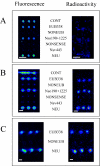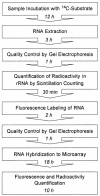The isotope array, a new tool that employs substrate-mediated labeling of rRNA for determination of microbial community structure and function
- PMID: 14602652
- PMCID: PMC262286
- DOI: 10.1128/AEM.69.11.6875-6887.2003
The isotope array, a new tool that employs substrate-mediated labeling of rRNA for determination of microbial community structure and function
Abstract
A new microarray method, the isotope array approach, for identifying microorganisms which consume a (14)C-labeled substrate within complex microbial communities was developed. Experiments were performed with a small microarray consisting of oligonucleotide probes targeting the 16S rRNA of ammonia-oxidizing bacteria (AOB). Total RNA was extracted from a pure culture of Nitrosomonas eutropha grown in the presence of [(14)C]bicarbonate. After fluorescence labeling of the RNA and microarray hybridization, scanning of all probe spots for fluorescence and radioactivity revealed that specific signals were obtained and that the incorporation of (14)C into rRNA could be detected unambiguously. Subsequently, we were able to demonstrate the suitability of the isotope array approach for monitoring community composition and CO(2) fixation activity of AOB in two nitrifying activated-sludge samples which were incubated with [(14)C]bicarbonate for up to 26 h. AOB community structure in the activated-sludge samples, as predicted by the microarray hybridization pattern, was confirmed by quantitative fluorescence in situ hybridization (FISH) and comparative amoA sequence analyses. CO(2) fixation activities of the AOB populations within the complex activated-sludge communities were detectable on the microarray by (14)C incorporation and were confirmed independently by combining FISH and microautoradiography. AOB rRNA from activated sludge incubated with radioactive bicarbonate in the presence of allylthiourea as an inhibitor of AOB activity showed no incorporation of (14)C and thus was not detectable on the radioactivity scans of the microarray. These results suggest that the isotope array can be used in a PCR-independent manner to exploit the high parallelism and discriminatory power of microarrays for the direct identification of microorganisms which consume a specific substrate in the environment.
Figures







References
Publication types
MeSH terms
Substances
Associated data
- Actions
- Actions
- Actions
LinkOut - more resources
Full Text Sources
Other Literature Sources

